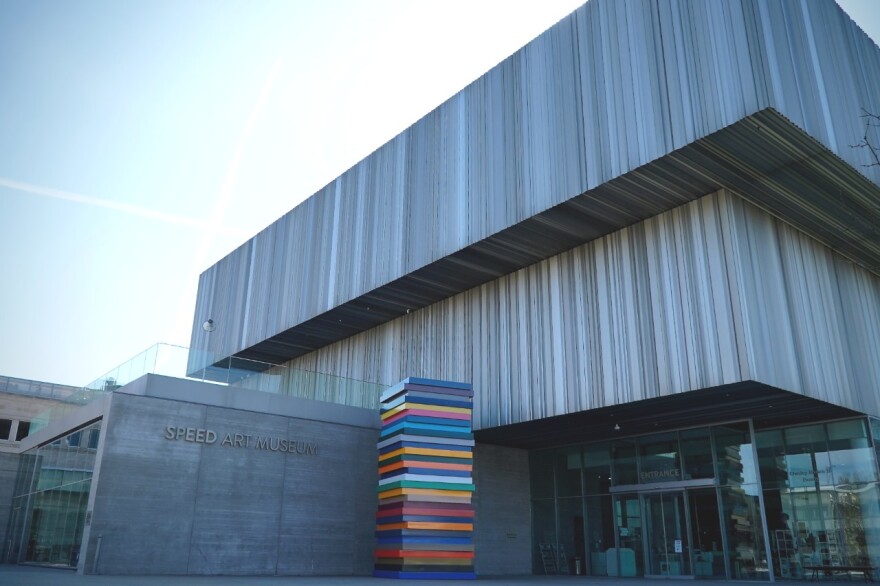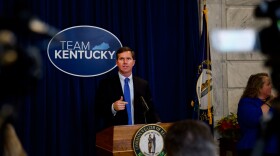89.3 WFPL News Louisville · Picasso, Monet, Other Works ‘Shelter In Place’ At The Speed Art Museum
Museums are “complicated machines.”
“They exist not just to welcome the public and to share the art, but to secure the art, to keep it safe in perpetuity,” said Speed Art Museum director Stephen Reily, describing the physical aspect of museums.
The museum has been essentially on “lockdown” since it closed to the public in mid-March. But just because the lights are dimmed, that doesn’t mean that there’s nothing happening inside.
Museums Jobs You Can’t Do From Home
They had to lay off some part-time and full-time workers from their 115-member staff, though they remain on the museum's benefits, Reily said. Others, like himself, are working from home. But then there are the jobs, like taking care of precious works of art, that can’t be done remotely.
“The only people who really are working in the building right now are those who are directly involved with...making this very complicated machine work in a safe and secure way,” Reily said.
Security guards keep a watchful eye over the museum round the clock, because the museum has many valuable pieces, from the likes of Monet and Picasso to artifacts from ancient cultures.
“While we don't talk about the numbers, we're fully staffed as we would have been when the museum was open,” Reily said.
They aren't just guarding the museum’s collection. Shortly before everything had to shutter to slow the spread of the novel coronavirus, the museum had wrapped up its “Tales from the Turf” exhibition, which Reily described as “our first-ever exhibit of equine art in our 93-year history” that featured work from about 46 different lenders.
He said much of that loaned artwork made it back home.
“But the process has now been halted,” Reily said. “It's not a great time to be shipping art back to people's homes and collections.”
Art’s Ideal Environment
Keeping art safe is about much more than just locking it up.
Museums, these complicated machines, are complicated because they have to provide the perfect habitat for the artwork they house: pristine, clean environments with specific temperatures and humidity levels.
“Environmentally, what feels comfortable to a human being, coincidentally, is an ideal setting for works of art,” said Kim Spence, the Speed’s director of collections and exhibitions and curator of works on paper.
That’s around 70 degrees Fahrenheit and about 50 relative humidity. Staying within a few degrees either direction of these optimal conditions are important because art “expands and contracts” as these elements change.
“Wood furniture can crack, paint layers can flake and drawings on paper can warp,” she said.
Staff monitor the humidity and temperature 24/7, whether or not the world is experiencing a pandemic. That work can be done remotely, at least for the most part, Spence said, because the museum uses a “sophisticated computer system” to both stabilize and monitor the conditions.
“If a cold front moves through Kentucky and temperature and humidity levels start to drop, someone in our facilities department receives an alert so they can make adjustments to the system,” Spence said.
As a backup, security teams also check the meters on the museum’s redundancy systems when they make their regular rounds.
Other on-site staff keep the museum clean and sanitized. Then there are those tasked with regular maintenance of the museum’s collections. You can’t just turn off the lights, lock the doors and expect everything to be as you left it.
Preparators and art handlers continue to move art in or out of storage, work in gallery spaces and install upcoming exhibitions, like the blockbuster Andy Warhol show that was supposed to open in early April, Spence said. And they do it while social distancing at between six and 10 feet.
“Our preparators can work on separate projects, in different galleries, in different parts of the building,” she said. “Staff wear gloves whenever possible, and of course, everyone is encouraged to wash their hands, a lot.”
‘Art Sheltering In Place’
In some ways, like people, “the art is sheltering in place” too, Spence said. They’ve reduced lighting because too much light exposure can damage art, so the shutdown is giving the works a reprieve from that.
“Limiting light exposure helps extend the lifespan of artworks,” Spence said.
They’ve also covered pieces that are light sensitive or prone to fading with black plastic as an extra layer of protection.
Director Stephen Reily said the current environment showcases an “interesting tension” for museums: They are both a “temple” for the preservation of art and a place for the community to connect with it.
“The art may be breathing a sigh of relief for the moment,” he said. “But I think if art had a mind, it would also probably prefer having people enjoying it with their families and friends in a world that's not being torn apart by a pandemic.”








